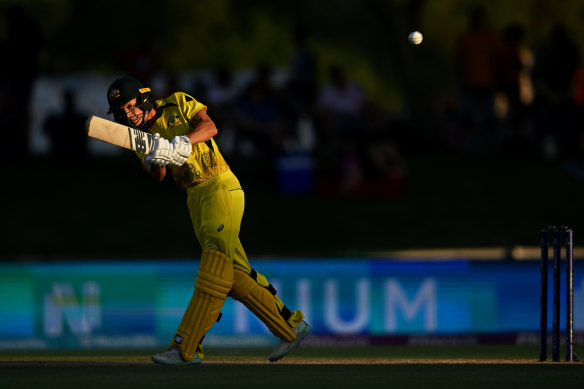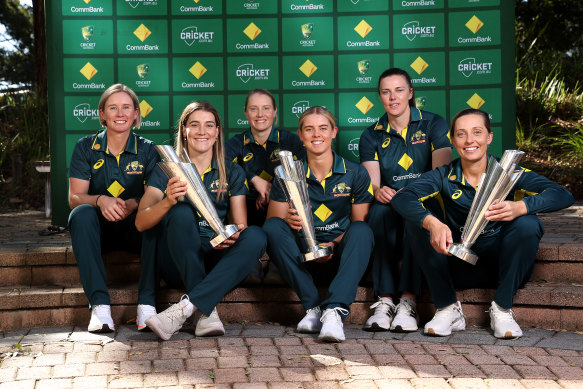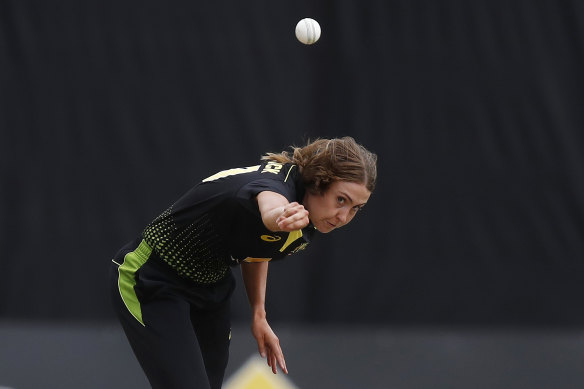When Australia chase an unprecedented seventh Twenty20 World Cup title in the UAE from Saturday, they will be trying to do so without perhaps the most integral member of five of those victorious teams.
Following her emotional retirement last year, former captain Meg Lanning will be watching with interest, if not quite the same high level of focused anxiety that characterised her outstanding leadership of the team for nearly a decade.

Meg Lanning during the 2023 World Cup.Credit:Getty Images
Now led by Alyssa Healy, Australia’s opening game will be against Sri Lanka, a team that so nearly forced Australia’s early elimination from the 2020 edition of the tournament. Lanning laughs when reminded of that tense affair at the WACA Ground, a reminder of some of the things she won’t miss about the tournament.
“I’ll miss the big games and knowing there’s a lot on the line,” Lanning said of a tournament that will be broadcast on Prime Video in Australia. “I really enjoy those moments. So that side of things I’ll miss, but everything else around it, the commitment levels required and that sort of thing, are past me now. So I don’t miss that.”
In 2020, Australia forged on to squeeze past South Africa in a rain-affected semi-final and then flourish in front of a huge crowd at the MCG for the decider. Finding a way to battle through is, according to Lanning, one of the most vital components of Australian success: with five World Cup medals, she should know.
“It might start off pretty free-flowing, but as it goes on you have to grind your way through. The teams that can do that the best will be successful, and that’s why Australia’s been so successful in winning the key moments and battles when you’re under the pump.”
Quick adaptation to the unknown
Due to political unrest in Bangladesh, this year’s World Cup has been moved to the UAE, a familiar venue for men’s events but never before the host of a women’s tournament.
The pitches are expected to be of the slower and lower variety, but that does not necessarily mean a spin-heavy approach will work best. Lanning says Healy and company will need to be able to make snappy decisions about the conditions they face.
“The unknown presents a little bit of a challenge, just in terms of how quickly you adapt to the conditions,” Lanning said. “We’ve got some really good pace and spin options, so I don’t think that’s necessarily an issue.
“It’s the best 15 players, but how we use those players, we’ve got good pace options in [Tayla] Vlaeminck and [Darcie] Brown, and our spin options stack up as well, so how we use them is going to be important. In T20 you don’t have much time to play catch-up if you don’t get it right from the start, so that’s going to be one of the biggest challenges, working out whether pace works better or spin.”
No more easy games
Lanning revealed that, in past World Cups, the Australians would often focus on group games they expected to be most difficult. But as the professionalism of the women’s game grows, such considerations are now much riskier to make.
“Generally in the past we’ve had two games where you go ‘that’s going to be hard’, so you think New Zealand and India in our group,” she said. “But Pakistan and Sri Lanka present their own challenges. They’ve shown over the past couple of years that they’re just as capable of playing well. There’s no room for slip-ups really, and the big challenge up-front is getting through the group.
Tayla Vlaeminck.
“You don’t have to play your best cricket; that’s really important to know as well. In previous World Cups we had some spanners [in the works] and lost some games, but we peaked at the right time. You’ve still got to be able to scrape over the line if you don’t play as well, and that might need to be the case here. It’s five overs here, and five overs there that decide the game. T20 is very fickle, so make sure we don’t start too slowly.”
Beware the rise of India
Asked why Australia has won global trophies so often in recent years, Lanning leans towards the view that calmness under pressure has often won out over pure talent.
That is particularly the case against India. With the women’s IPL in growth mode, they are now catching up to the performance systems of Australia and England. The UAE, Lanning believes, is where a great sense of composure through experience may be about to come to the surface.
“Talent-wise, India are as good as any,” she said. “The bit they haven’t quite nailed yet is performing under pressure in key moments, which has won us the last two big tournaments. That will change at some point. The WPL has fast-tracked that a touch, so I think India are the key threat in this tournament because of the pure talent they’ve got, and if they can manage themselves in the big moments and be able to hold their nerve, then they’ll be pretty hard to beat.
“England are always strong. They’ve got the experience and they’ve added a few younger players, so they’ll always be a threat. They talk a lot about trying to take the game on and play fearlessly, and that’s good, but doing it under pressure in a World Cup is a different thing. ”
Bat deep, bowl deep
The other area where Australia still appear to have an edge on the field is in how much depth they have in the line-up. In the recent series decider against New Zealand in Brisbane, Test centurion Annabel Sutherland was listed to bat at eight, while Ellyse Perry did not have to bowl.
Such riches are extremely valuable in knockout games, in which Lanning says all players, regardless of how collected they might seem, are trying to make sound decisions while dealing with the pressure of the moment.

Beth Mooney (left), Annabel Sutherland, Alyssa Healy, Phoebe Litchfield, Tahlia McGrath and Ashleigh Gardner are all part of Australia’s T20 world cup squad.Credit:Getty Images for Cricket Australia
“The pressure on the end of the game definitely plays on people’s minds, and it is a matter of who can deal with that the best,” she said. “We don’t just rely on one or two players now, which I think is a big advantage. Especially in T20 cricket. Given the nature of it, people are going to fail at different times, but if you’ve got a number of different people who can stand up, then that makes a big difference.
“That’s what has been so good for us over a long period of time. If you’re reliant on one or two people it’s going to come unstuck in one game, and more often than not it’s in the big games, the semis and the final where you can’t afford it.”




